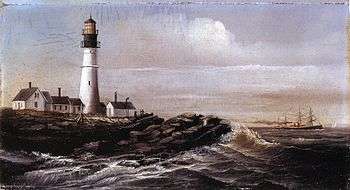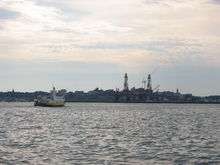Casco Bay

Casco Bay is an inlet of the Gulf of Maine on the southern coast of Maine, New England, United States. Its easternmost approach is Cape Small and its westernmost approach is Two Lights in Cape Elizabeth. The city of Portland sits along its southern edge and the Port of Portland lies within.
European discovery
There are two theories on the origin of the name "Casco Bay". Aucocisco is the Abenaki name for the bay, which means 'place of herons' (sometimes translated as 'muddy').[1] The Portuguese explorer Estêvão Gomes, mapped the Maine coast in 1525 and named the bay "Bahía de Cascos" (Bay of Helmets, based on the shape of the bay).
The first settlement in Casco Bay was that of Capt. Christopher Levett, an English explorer, who built a house on House Island in 1623-24. The settlement failed.[2] The first permanent settlement of the bay was named Casco; despite changing names throughout history, that settlement remains the largest city in the Casco Bay region, now called the city of Portland, Maine
It was first reported in 1700 by Colonel Wolfgang William Römer, an English military engineer, that there were "as many islands as there are days in the year".[3] The United States Coastal Pilot lists 136 islands,[3] leading to the bay's islands being called that Calendar Islands based on the popular myth there are 365 of them. Later, Robert M. York, the former Maine state historian said there are "little more than two hundred islands".[4]
History
War of 1812
Casco Bay is also home to abandoned military fortifications dating from the War of 1812 through World War II; during World War II, Casco Bay served as an anchorage for US Navy ships.
World War I
See Forts of Casco Bay below.
World War II
Since Casco Bay was the nearest American anchorage to the Atlantic Lend-Lease convoy routes to Britain prior to US entry into World War II, Admiral King ordered a large pool of destroyers to be stationed there for convoy escort duty in August 1941.[5]
The State Historic Site of Eagle Island was the summer home of Arctic explorer Robert Peary.
Late 20th and early 21st centuries
Walter Cronkite stated that, in his opinion, the bay offered some of the best sailing in the world.
In 2008, up-and-coming composers Peter J. McLaughlin and Akiva G. Zamcheck wrote a piece in four movements paying homage to the wreck of the Don in Casco Bay in 1941. The piece received critical acclaim from the Portland Press Herald and from fellow Maine composers.[6]
Marine economy
Portland has a substantial fleet of deep-sea fishing vessels which offload their catch primarily at the Portland Fish Exchange. Numerous towns and islands serve as ports for lobster boats. Recreational fishing boats can also be chartered.
Marinas include
- Chebeague Island Boat Yard on Great Chebeague Island;
- Diamond Marine Service Inc. on Great Diamond Island;
- Dolphin Marina and Great Island Boat Yard in Harpswell;
- Handy Boat Service Inc. in Falmouth;
- DiMillo's Old Port Marina, Maine Yacht Center and Portland Yacht Services in Portland;
- Peaks Island Marina on Peaks Island;
- Port Harbor Marina, South Port Marine, Spring Point Marina and Sunset Marina in South Portland;
- Brewer's and Strouts Point Wharf Co. in South Freeport;
- Royal River Boat Yard, Yankee Marina and Boatyard and Yarmouth Boat Yard in Yarmouth.
During the 1980s and 1990s, Bath Iron Works operated a dry dock in Portland Harbor to repair US Navy vessels, but that operation was discontinued.
Ecology
Predominant fish in the bay include mackerel, striped bass, and bluefish. Shellfish include lobsters, crabs, mussels, clams and snails. Harbor seals congregate on certain exposed ledges, and whales on occasion swim into the bay, and in a few instances into Portland Harbor. Seagulls, cormorants and varying species of ducks are the most common birds; more rarely osprey, eagles and herons have been sighted. Casco Bay contains bay mud bottoms and banks in some locations, providing important substrates for biota.
Transportation

The major islands in the bay are served by the Casco Bay Lines ferry service at the Maine State Pier in Portland. Peaks Island is served by a car ferry and, during the summer, sees 16 ferries a day. The other islands see fewer ferries and no car transport. Great and Little Diamond islands and Long Island are served primarily by the Diamond Pass run, which is popular with tourists in the summer months. Other services offered by Casco Bay Lines include a daily mailboat run, a cruise to Bailey Island, and a sunset run.
Other services such as water taxis are also popular alternatives to the ferry, but are limited to six passengers per boat.
Notable cities and towns
From south to north:
- Cape Elizabeth
- South Portland
- Portland
- Falmouth
- Cumberland
- Yarmouth
- Freeport
- Brunswick
- Harpswell
- Bath
Islands
Major islands
- Bailey Island
- Bustins Island
- Cliff Island
- Cousins Island
- Cushing Island
- Great Diamond Island
- Great Chebeague Island
- Long Island
- Mackworth Island
- Orr's Island
- Peaks Island
- Sebascodegan Island (Great Island)
Minor islands[7]
- Bangs Island
- Basket Island
- Barnes Island
- Bartol Island
- Basin Island
- Bates Island
- Bear Island
- Ben Island
- Big Hen Island
- Birch Island
- Bombazine Island
- Bowman Island
- Bragdon Island
- Burnt Coat Island
- Bush Island
- Center Island
- Clapboard Island
- Coombs Islands
- Cow Island
- Crab Island
- Crow Island
- Dingley Island
- Eagle Island
- East Brown Cow Island
- Elm Islands
- French Island
- George Island
- Gooseberry Island
- Goose Nest Island
- Great Mark Island
- Halfway Rock
- Harbor Island
- Haskell Island
- Hope Island
- Horse Island
- Home Island
- House Island
- Inner Green Island
- Irony Island
- Jacquish Island
- Jenny Island
- Jewel Island
- Junk of Pork
- Lanes Island
- Little Bustins Island
- Little Chebeague Island
- Little Birch Island
- Little Diamond Island
- Little French Island
- Littlejohn Island
- Little Mark Island
- Little Moshier Island
- Little Snow Island
- Little Whaleboat Island
- Lower Goose Island
- Malaga Island
- Mark Island
- Ministerial Island
- Moshier Island
- Mouse Island
- Outer Green Island
- Overset Island
- Pettingill Island
- Pinkham Island
- Pole Island
- Pound of Tea
- Pumpkin Nob
- Ragged Island
- Ram Island
- Raspberry Island
- Rogue Island
- Sand Island
- Scrag Island
- Sheep Island
- Shelter Island
- Snow Island
- Stave Island (home to Survivor Gabon winner Bob Crowley)
- Stockman Island
- Sister Island
- Sow and Pigs
- Sturdivant Island
- Turnip Island
- Two Bush Island
- Upper Flag Island
- Upper Goose Island
- Upper Green Island
- The Brothers
- The Goslings
- The Nubbin
- Vail Island
- Whaleboat Island
- White Island
- White Bull Island
- Williams Island
- Wood Island
- Yarmouth Island
Lighthouses
Casco Bay is home to 7 lighthouses:
- Cape Elizabeth Lights
- Portland Head Light
- Ram Island Ledge Light
- Spring Point Ledge Light
- Portland Breakwater (Bug) Light
- Halfway Rock Light
- Pocahontas (Echo Point) Light, the smallest lighthouse registered with the United States Coast Guard, it stands only 6 feet tall
Forts
Forts in Casco Bay:
| Fort | Constructed |
Location |
|---|---|---|
| Fort Gorges | 1865 | Hog Island Ledge, Portland, ME |
| Fort Levett | 1898 | Cushing Island, Portland, ME |
| Fort Lyon | 1909 | Cow Island, Portland, ME |
| Fort McKinley | 1907 | Great Diamond Island, Portland, ME |
| Fort Preble | 1808 | Southern Maine Community College/Spring Point Ledge Light, South Portland, ME |
| Fort Scammel | 1808 | House Island, Portland, ME |
| Fort Williams | 1872 | Fort Williams Park, Cape Elizabeth, ME |
| Battery Steele | 1942 | Peaks Island, Portland, ME |
Newspapers
The newspaper for Portland, the largest city in Casco Bay, is the Portland Press Herald (Maine Sunday Telegram on Sundays). The Island Institute publishes The Working Waterfront, a free monthly newspaper reporting "the news of Maine's coast and islands." For Southern Maine news, obituaries and sports, The Forecaster is published weekly.
See also
References
- Caldwell, Bill (1982). The Islands of Casco Bay.
- Bibliography of Casco Bay
- ↑ The Islands of Casco Bay, page 4
- ↑ James Phinney Baxter (1893). Christopher Levett, of York: The Pioneer Colonist in Casco Bay. The Gorges Society.
- 1 2 The Islands of Casco Bay, page 3
- ↑ http://abacus.bates.edu/pubs/mag/96-Winter/york.html
- ↑ Heinrichs, Waldo (1988). Threshold of War: Franklin D. Roosevelt & American Entry into WWII. Oxford: Oxford University Press. p. 165. ISBN 0195061683.
- ↑ http://cascobayfilms.blogspot.com/p/about-casco-bay.html
- ↑ "Archived copy". Archived from the original on 2009-12-19. Retrieved 2010-08-09.
Coordinates: 43°38′00″N 70°02′58″W / 43.63333°N 70.04944°W